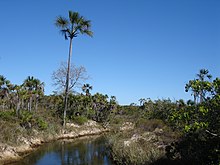 Cover for the Italian edition | |
| Author | João Guimarães Rosa |
|---|---|
| Original title | Grande Sertão: Veredas |
| Translator | James L. Taylor Harrient de Onis |
| Language | Portuguese |
| Genre | novel |
| Set in | Sertão, early 20th century |
| Publisher | José Olympio |
Publication date | 1956 |
| Publication place | Brazil |
Published in English | 1963 |
| Pages | 450 |
| 869.342 | |
| LC Class | PQ9697.R76 |

The Devil to Pay in the Backlands (Portuguese: Grande Sertão: Veredas, "Great Backlands: Paths"; also translated as The Great Backlands and Their Paths) is a novel published in 1956 by the Brazilian writer João Guimarães Rosa.
The original title refers to the veredas, which are small paths through wetlands usually located at higher altitudes characterized by the presence of grasses and buritizais, groups of the buriti palm-tree (Mauritia flexuosa),[1] that criss-cross the Sertão region in northern Minas Gerais as a labyrinthine net where an outsider can easily get lost, and where there is no single way to a certain place, since all paths interconnect in such a way that any road can lead anywhere. The English title refers to a later episode in the book involving an attempt to make a deal with the Devil. Most of the book's spirit is, however, lost in translation, as the Portuguese original is written in a register that is both archaic and colloquial, as well as full of the author's remarkable neologisms, which makes the aesthetics of the book a challenging task to transpose to other languages. The combination of its size, linguistic oddness and polemic themes caused a shock when it was published, but now it is widely regarded as one of the greatest works of Brazilian literature and one of the most important novels of Portuguese language literature and South American literature. In a 2002 poll of 100 noted writers conducted by the Bokklubben World Library, the book was named among the top 100 books of all time.[2]
- ^ Martius & Spix. Viagem pelo Brasil. 1828, p. 109.
- ^ The top 100 books of all time, Guardian Unlimited, May 8, 2002